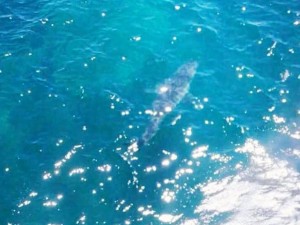Aquatic scientific names in the news …
Great white shark
A Great white shark estimated to be around 7m in length was spotted about 200m offshore at Marino Rocks, near Adelaide, Australia on Sunday 17th Jan. Local newspaper, The Advertiser, reported that a Westpac Lifesaver Rescue helicopter tried to herd the shark out to sea where it made its way into deeper water and that it had not been seen again.
The size of this fish puts it on a par with the fictional shark from the Jaws movies and, if accurate, makes it one of the largest Great whites to have been photographed; the average length of a mature specimen is likely to be around 4 – 5.2m with females being larger than males, the maximum total length for this species is subject to speculation and is often grossly exaggerated but the largest reliable record is 6.4m.
 Image: Shark Alerts SA (click to enlarge)
Image: Shark Alerts SA (click to enlarge)
Shark Alerts South Australia, an organisation that reports shark sightings in South Australia for swimmers, surfers and other coastal water users, confirmed the estimated size using their six-metre jet boat to provide a comparison finding the shark to be larger.
Carcharodon carcharias (Linnaeus, 1758), the Great white shark or White pointer
Etymology.
Carcharodon – Greek, Carchar-, carcharos (καρχαρος), saw-like, jagged; -odon (οδον), odous (οδους), tooth; καρχαροδους, with saw-like teeth.
carcharias (καρχαριας) – Greek, shark, so called from its saw-like teeth.
Linnaeus’s original name for the species before it was moved to the more recent genus was Squalus carcharia (Squalus – Latin, a kind of sea-fish (classical); shark (scientific Latin)) – loosely speaking, shark with saw-like teeth.
In common with a number of other carnivorous shark species, those preying on other sharks, cetaceans (dolphins, porpoises, whales), and pinnipeds (seals and sea-lions) they have a combination of pointed lower teeth with broad triangular serrated upper teeth. The lower teeth allow for the prey to be gripped whilst the upper teeth with their serrated edges cut it into smaller easily swallowed pieces.